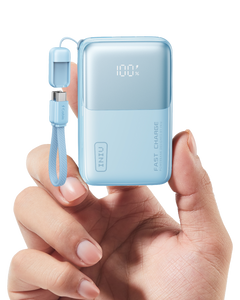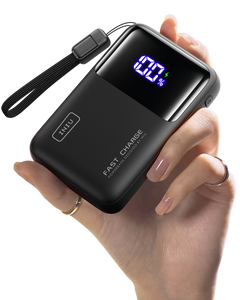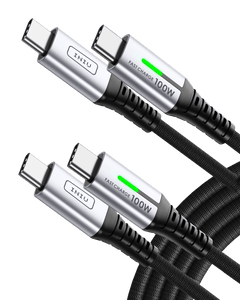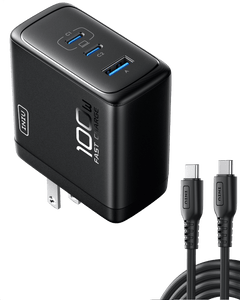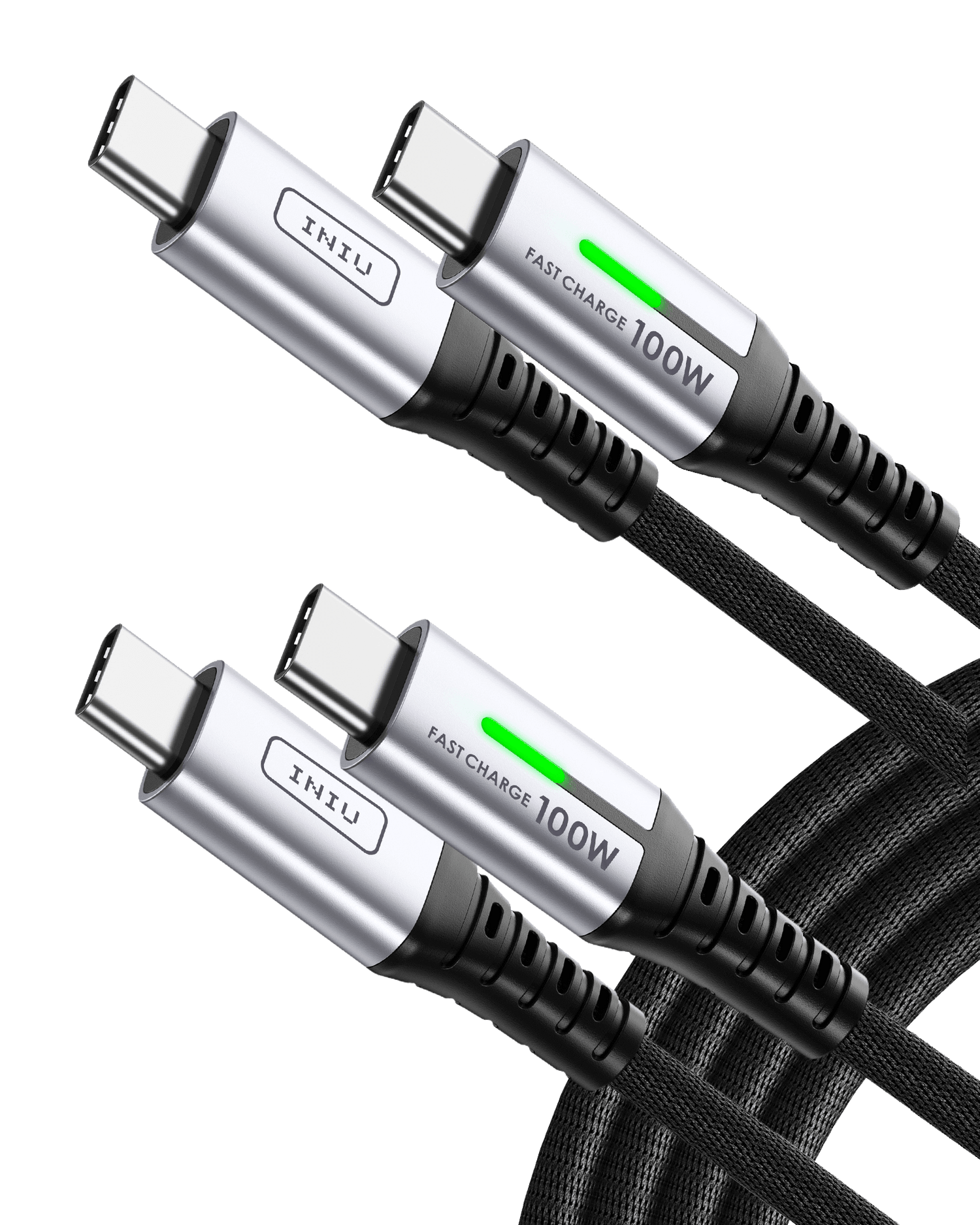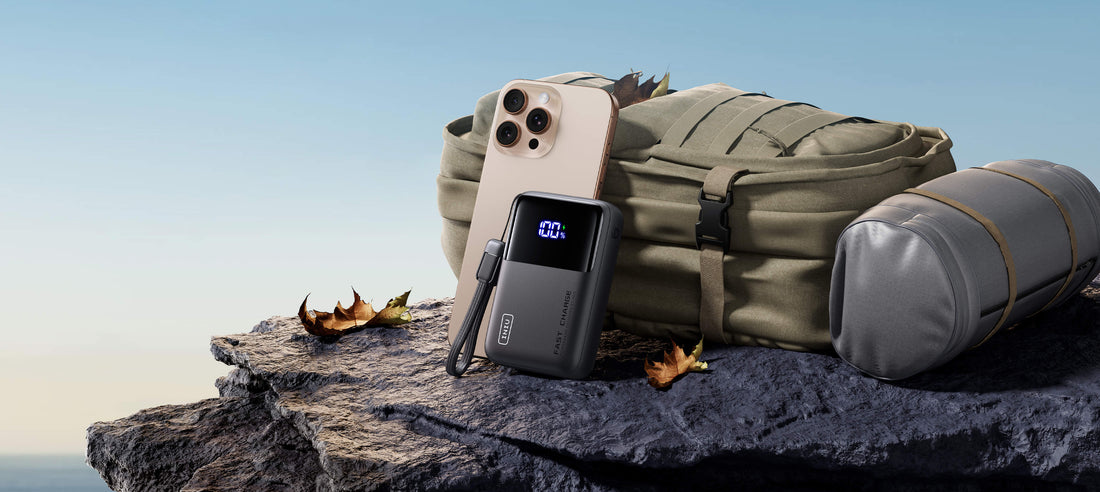
Stay Charged on Your Outdoor Fall Activities 丨 Outdoor Power Gear
Imagine the perfect autumn scene: crisp air, golden leaves on your scenic fall road trip, and a fiery sunset over Falls Lake during your weekend camping getaway. You reach for your phone to capture the view—and your battery is full. That's the moment every outdoor enthusiast wants.
In the age of digital maps, GPS tracking, drone photography, and endless photo ops, running out of battery isn't just inconvenient—it can cut you off from safety, memories, and connection.
This guide will help you understand how to stay powered wherever your adventures take you. From selecting the best power bank for outdoor activities to pairing it with the right cables and chargers, we'll ensure you're equipped for every moment—whether you're hiking a forest trail, setting up camp by the lake, or taking a spontaneous fall road trip.
Why a Charging System is Your Most Essential Autumn Tech Gear

When it comes to outdoor fall adventures, your charging setup is as essential as your boots or tent. Think of it as a three-part system: the power bank, the cable, and the wall charger. Each plays a unique role, and together they keep your devices ready for anything.
The Heart of Your Setup: The Power Bank
Your power bank is the portable energy reservoir that gives you the freedom to roam farther and stay longer. It's what keeps your phone alive for emergency calls, your camera powered for golden-hour shots, and your GPS ready to guide you back to camp.
An outdoor power bank is a safety essential. Whether you're trekking through forest trails or camping off-grid, it ensures you're never powerless when it matters most.
The Lifelines: High-Quality Charging Cables
Even the best power bank can't help if your cable fails. Cheap, flimsy cables often fray or charge inefficiently, especially after being stuffed in a backpack or exposed to the elements.
Invest in durable, braided cables depending on your devices. They resist wear and deliver consistent, fast charging, making them an unglamorous but indispensable part of your gear.
The Home Base: A Powerful Wall Plug (Charger)
Your charging strategy starts before the trip. A fast wall charger, preferably one utilizing GaN (Gallium Nitride) technology, ensures that your high-capacity power bank reaches 100% charge quickly.
Instead of waiting 12 hours for a slow charge, a 30W or higher GaN plug can refill a 20,000mAh battery in just a few hours—saving you time and frustration.
What Really Matters in a Power Bank for Camping and Outdoor Travel
Power banks aren't one-size-fits-all. Understanding the key specs helps you make the right choice for your style of adventure—whether it's camping, hiking, or traveling cross-country.
Capacity (mAh): How Much Power Do You Actually Need?
Milliamp-hours (mAh) measure how much charge a power bank can store. But not all of that power reaches your device—conversion losses mean you'll typically get about 60–75% of the rated capacity.
Here's how to choose based on your trip:
Day Hikes (Under 10,000mAh): Lightweight and pocketable, perfect for topping off your phone or earbuds during a short hike.
Weekend Camping / Fall Road Trips (10,000–20,000mAh): The “sweet spot” for most travelers. Enough to charge multiple devices several times, while still being easy to pack.
Extended Expeditions / Power Users (Over 20,000mAh): For photographers, drone users, or multi-device travelers who go off-grid for days. This is where a high-capacity power bank truly shines.
Charging Speed (Watts & Protocols): Don't Wait Forever
If your power bank charges your phone slowly, it's probably missing the right fast-charging protocol. Look for PD (Power Delivery) and QC (Quick Charge) support. These ensure your devices recharge at optimal speeds—whether it's a smartphone, tablet, or even a laptop.
Output power is the biggest factor in determining charging speed. If the device being charged supports it, higher power output provides faster charging speeds. A power bank with a 5W output will charge much more slowly than a newer 45W power bank. At the same time, high-power devices require greater power input. If you want to charge your drone or laptop outdoors, a low-power power bank may not be able to meet your charging needs.
Portability vs. Power & Durability
More capacity means more weight—but context matters. For car camping or road trips, a heavier bank is fine. For long-distance hiking, a compact, mid-range option is smarter. If you'll be outdoors frequently, look for rugged designs.
INIU Power Banks That Fit Outdoor Life
INIU offers compact, high-performance options designed specifically to meet the demands of outdoor life—from quick day hikes to multi-day camping and travel.
INIU P50-E1 — Compact 10,000mAh, 45W (Excellent for Day Trips & Lightweight Carry)
The INIU P50-E1 is a very compact 10,000mAh power bank that delivers up to 45W output in a pocketable size and weighs roughly 160g—designed to be small without sacrificing speed. It's a great everyday-carry option for day hikes or short outings when you want fast-charging in a truly portable package. The P50-E1 is part of INIU's Carry series that emphasizes a tiny footprint with high output.
Why it works for outdoors:
- Ultra-portable for day hikes or quick fall road stops.
- 45W output can top up phones quickly and handle light laptops or handheld consoles for short bursts.
- Lightweight and pocket-friendly.
INIU P62-E1 — 20,000mAh, 65W (Weekend Camping & Travel Workhorse)
For weekend camping, longer hikes, or fall road trips where you need more capacity, the INIU P62-E1 is a solid fit: 20,000mAh capacity with up to 65W output, packed into a compact footprint (about 11.4 oz / 324 g). It's designed to charge phones, tablets, some laptops, and multiple devices across a few days of use.
Why it works for outdoors:
- 20,000mAh gives multiple phone charges and can support a tablet or small laptop in a pinch.
- 65W output ensures faster charging for larger devices and better multi-device power management.
How to Choose Your Best Power Bank for Travel & Outdoors: A 4-Step Checklist
Choosing your perfect power companion doesn't have to be confusing. Follow these four simple steps:
List Your Devices & Charging Needs
What will you charge—phones, cameras, smartwatches, or drones? Do your devices support wireless charging? Your answers determine how many ports and features you'll need.
Define Your Trip Length
For day hikes, a 10,000mAh unit may suffice. For multi-day camping or long road trips, 20,000mAh or higher ensures uninterrupted power.
Consider Your Activity
Backpackers prioritize lightness; car campers can handle a bulkier, high-capacity setup. Match your power bank to your travel style.
Set Your Budget & Check for Quality
Stick with reputable brands (like INIU) that emphasize safety features, battery protection, and certifications. A cheaper, uncertified power bank might overheat or fail when you need it most.
The Supporting Cast: Don't Forget Your Cables and Wall Charger
Don't overlook the details—using the right cables and wall charger can dramatically improve charging speed, efficiency, and durability, especially when you're on the go or off the grid.
The Right Cables Make a Difference
Pack the correct cables for all your devices—USB-C to C for most modern Androids, tablets, and laptops, and USB-C to Lightning for Apple devices. For outdoor use, durability is key: braided nylon designs resist fraying and perform reliably in cold, damp, or rugged conditions.
A perfect match is the INIU D5CC USB-C to USB-C Cable, rated for 100W Power Delivery (5A) and supporting 480 Mbps data transfer. Built with FLYWEAVE braided nylon and reinforced connectors that have passed 45,000+ bending tests, this cable is engineered to withstand the wear and tear of travel, hiking, or camping. Its E-Mark smart chip ensures safe, stable charging even for high-wattage devices like laptops or high-capacity power banks—making it an essential companion for any outdoor power setup.
The Unsung Hero: A Powerful GaN Wall Plug
A GaN wall charger is compact, efficient, and powerful—an indispensable tool for recharging your devices and power bank quickly before your next trip. Look for high-wattage output to ensure you're never waiting around for a full charge.
The INIU A11-E1 100W GaN Charger delivers exceptional versatility and speed. Featuring three ports (2*USB-C and 1*USB-A), it provides up to 100W total output, with single-port 100W PD capability—enough to fast-charge a laptop, tablet, or a 20,000mAh power bank simultaneously. Built with advanced GaN technology, it runs cooler and more efficiently than traditional silicon chargers while remaining compact enough to fit neatly into any backpack or travel pouch.
Flying This Fall? Understanding Airline Power Bank Regulations

If your adventures involve flying, it's vital to know the airline rules for carrying power banks.
The Golden Rule:
Power banks must be packed in your carry-on luggage instead of checked bags.
The Watt-Hour (Wh) Limit:
Airlines typically limit lithium batteries to 100Wh per device without special approval.
To ease your mind, here's a simple formula:
(mAh ÷ 1000) × Volts = Wh
For example, a 20,000mAh power bank with a 3.7V cell = 74Wh, comfortably below the 100Wh threshold. That's another reason why a 20,000mAh model—like the INIU P62-E1—is the best power bank for travel. It gives you maximum power while staying airline-safe.
FAQ
Q: Can I leave my power bank charging overnight?
Yes, reputable brands like INIU include built-in protection circuits to prevent overcharging or overheating. However, to maximize long-term battery health, it's best to unplug once fully charged rather than leaving it connected for several days.
Q: How should I store my power bank?
Store it in a cool, dry place away from direct sunlight or extreme temperatures. Avoid leaving it in a hot car or freezing outdoor conditions, as heat can degrade battery chemistry and cold can temporarily reduce performance.
Q: What if my power bank gets cold during outdoor trips?
Cold weather can temporarily slow down charging and reduce effective capacity. To restore performance, warm the power bank gradually by keeping it close to your body or in a dry, insulated bag. Never use direct heat sources like a fire or heater, as that can damage the battery.
Q: Power bank vs. portable charger—what's the difference?
There's essentially no difference. Both terms refer to an external battery that charges devices on the go. Some brands may call them “portable chargers” for marketing purposes, but functionally, they serve the same role as a power bank.
Conclusion
A successful outdoor adventure isn't just about where you go—it's about how prepared you are when you get there. Investing in a complete charging system, centered around a versatile power bank like the INIU P62-E1, ensures that your phone, camera, and GPS stay powered from start to finish.
So pack smart, charge up, and get out there to enjoy the brilliant colors of fall—fully powered, fully present, and ready for anything.



